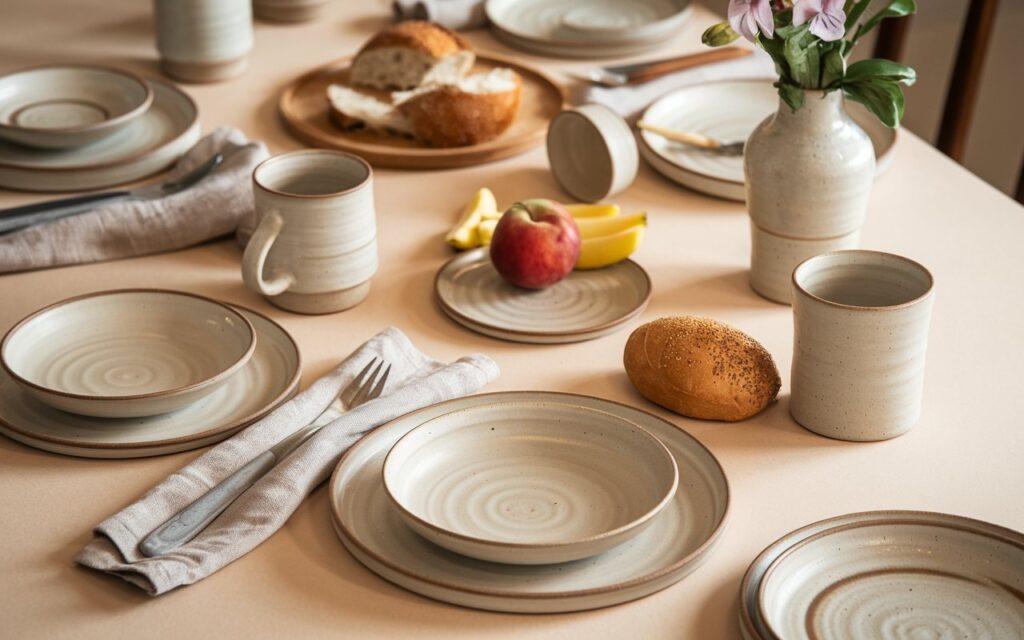In a world increasingly dominated by mass-produced goods, ceramic tableware stands as a testament to the enduring value of handcrafted artistry. These thoughtfully created pieces do more than simply hold food—they transform everyday meals into meaningful rituals and special occasions into memorable celebrations. Let’s explore the rich world of ceramic tableware and discover how these pieces can enhance both your dining experience and home aesthetic.

The Timeless Appeal of Ceramic Tableware
Ceramics have been at the heart of human dining experiences for thousands of years. From ancient pottery shards unearthed by archaeologists to the fine porcelain of royal courts, ceramic vessels tell the story of human civilization and our enduring desire to combine functionality with beauty.
Today’s ceramic tableware continues this tradition while embracing contemporary design sensibilities. Modern ceramics offer several compelling advantages over mass-produced alternatives:
- Unmatched character and uniqueness in each handcrafted piece
- Superior durability that can last for generations with proper care
- Excellent heat retention to keep foods at optimal temperatures
- Non-toxic, food-safe materials free from harmful chemicals
- Sustainable production practices with minimal environmental impact
According to The New York Times Wirecutter, the investment in quality ceramic tableware is justified not only by its longevity but by the daily pleasure it brings to ordinary meals.
Understanding Different Ceramic Types
Not all ceramics are created equal. Understanding the different types can help you select pieces that best suit your lifestyle and aesthetic preferences:
Earthenware
Earthenware is fired at lower temperatures (1,800°F to 2,100°F), resulting in a porous, less durable ceramic that’s typically glazed to make it watertight. These pieces often feature vibrant colors and rustic textures that bring warmth and character to casual dining settings.
Characteristics of earthenware include:
- Lightweight and often less expensive
- Excellent for serving dishes and decorative pieces
- More susceptible to chipping and cracking
- Usually not suitable for oven or microwave use
Stoneware
Stoneware is fired at higher temperatures (2,100°F to 2,300°F), creating a dense, durable ceramic that’s perfect for everyday use. This versatile material strikes an ideal balance between durability and aesthetic appeal.
Characteristics of stoneware include:
- Exceptional durability for daily use
- Non-porous surface that resists bacteria
- Typically microwave, dishwasher, and oven-safe
- Available in a wide range of finishes from matte to glossy
- Often features speckled textures and earthy color variations
Porcelain
Porcelain is fired at extremely high temperatures (2,300°F to 2,400°F), resulting in a translucent, refined ceramic prized for its delicate appearance and surprising strength.
Characteristics of porcelain include:
- Elegant, translucent quality with a luminous appearance
- Surprisingly strong despite its delicate appearance
- Typically more formal in presentation
- Resistant to thermal shock and mechanical stress
- Often features more precise, refined designs
Bone China
Bone china incorporates bone ash into the clay mixture, creating an incredibly strong yet translucent ceramic that’s often reserved for fine dining and special occasions.
Characteristics of bone china include:
- Exceptional strength-to-weight ratio
- Beautiful translucency with a warm, creamy tone
- Elegant appearance suitable for formal settings
- Typically more expensive than other ceramics
- Often features delicate patterns and gold or platinum accents
The Rise of Artisanal Ceramic Tableware
In recent years, there has been a significant resurgence in appreciation for handcrafted pottery and artisanal ceramic tableware. This renewed interest reflects broader cultural shifts toward authenticity, sustainability, and mindful consumption.
Several factors have contributed to this renaissance:
The Maker Movement
The maker movement has reconnected consumers with the value of handcrafted goods and the stories behind them. Each piece of handmade ceramic tableware carries the imprint of its creator—subtle variations in glaze, unique throwing marks, and intentional design choices that mass-produced items simply cannot replicate.
Sustainability Concerns
As environmental awareness grows, many consumers are rejecting disposable and mass-produced plastic tableware in favor of durable, sustainable alternatives. Ceramic tableware offers exceptional longevity, biodegradable materials, and production processes that typically have a lower environmental impact than industrial manufacturing.
The Slow Dining Movement
The concept of slow dining—taking time to prepare and enjoy meals mindfully—has found a natural companion in handcrafted ceramics. These pieces encourage us to slow down, appreciate the sensory experience of dining, and connect more deeply with our food and dining companions.
Social Media Influence
Platforms like Instagram have showcased the visual appeal of ceramic tableware, with food photographers and stylists highlighting how the right plate or bowl can elevate both the presentation and enjoyment of a meal. This visibility has introduced a new generation to the beauty of ceramics.
Curating Your Ceramic Collection
Building a collection of ceramic tableware is a deeply personal journey that reflects your aesthetic preferences, entertaining style, and daily dining habits. Consider these approaches when developing your collection:
The Perfectly Imperfect Approach
Embrace the Japanese concept of wabi-sabi—finding beauty in imperfection—by collecting pieces with visible evidence of the maker’s hand. Slight variations in glaze, unique throwing marks, and intentional asymmetry create a collection with depth, character, and visual interest.
The Coordinated Mix
Rather than matching sets, consider a coordinated mix of pieces that share a color palette or design sensibility while maintaining individual character. This approach creates a cohesive table setting that avoids the rigidity of perfectly matched commercial sets.
The Functional Curation
Build your collection based on how you actually cook and entertain. Consider your typical serving styles, favorite cuisines, and entertaining habits. A thoughtfully curated collection might include:
- Everyday dinner plates in a durable stoneware
- Shallow pasta bowls for versatile serving
- Small condiment bowls for seasonings and sauces
- Statement serving platters for family-style meals
- Special occasion pieces in finer porcelain or bone china
The Seasonal Rotation
Some collectors enjoy rotating their ceramic tableware seasonally, using earthy tones and heavier pieces in fall and winter, then transitioning to lighter colors and more delicate forms for spring and summer dining.
Caring for Your Ceramic Tableware
Quality ceramic tableware can last for generations with proper care. Follow these guidelines to maintain the beauty and integrity of your collection:
Daily Care
- Hand washing is ideal, especially for handcrafted pieces with special glazes
- If using a dishwasher, select the gentle cycle and avoid overcrowding
- Use mild, non-abrasive detergents to protect glazes and decorative elements
- Allow hot ceramics to cool before washing to prevent thermal shock
- Store plates vertically rather than stacking to prevent scratches
Special Considerations
- Check with the maker regarding microwave, oven, and dishwasher safety
- Be particularly careful with gold or metallic decorative elements, which typically aren’t microwave-safe
- Avoid sudden temperature changes that can cause cracking
- Use felt separators between plates if stacking is necessary
- Display special pieces rather than storing them away—ceramics are meant to be enjoyed!
Finding Quality Ceramic Tableware
Whether you’re just beginning your collection or adding special pieces, here are some excellent sources for quality ceramic tableware:
Local Artisans and Pottery Studios
Supporting local ceramic artists provides the opportunity to meet the makers, understand their processes, and sometimes even commission custom pieces. Local craft fairs, studio tours, and artisan markets are excellent places to discover talented ceramicists in your area.
Specialty Retailers
Curated home goods stores often feature carefully selected ceramic collections from both established and emerging artists. These retailers typically provide detailed information about the makers and their techniques.
Online Marketplaces
Platforms dedicated to handcrafted goods have made it easier than ever to discover ceramic artists from around the world. These marketplaces often allow you to communicate directly with artists and learn about their inspiration and techniques.
Conclusion
Ceramic tableware represents far more than functional vessels for serving food—these pieces connect us to ancient traditions, support contemporary artisans, and transform our daily dining rituals into more meaningful experiences. By choosing handcrafted ceramics over mass-produced alternatives, we bring beauty, sustainability, and mindfulness to our tables.
Whether you’re drawn to rustic stoneware with earthy textures or refined porcelain with delicate glazes, the world of ceramic tableware offers endless possibilities for personal expression and elevated dining. Each piece tells a story—of its maker, its materials, and eventually, of the meals and memories it helps create in your home.
At Flomary, we appreciate the artistry and craftsmanship that goes into fine ceramic pieces, recognizing how they contribute to creating meaningful spaces and experiences in the home.
How has ceramic tableware enhanced your dining experience? Do you have favorite pieces with special stories or memories attached? Share your thoughts and experiences in the comments below!



